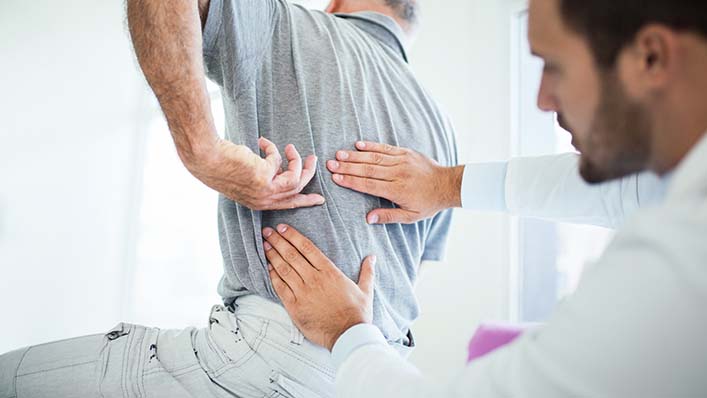In today’s fast-paced world, back pain is increasingly common, impairing the quality of life for many individuals. A particularly peculiar form is one-sided back pain, a condition that can be both confusing and alarming. It can range from a minor twinge that comes and goes to a relentless ache that impedes your daily activities. In this blog post, we’ll delve into the causes, prevention measures, and treatment options for one-sided back pain to help you understand, manage, and potentially overcome this disruptive condition.
Contents
Is Right Side Back Pain Normal?
 Experiencing pain, including right-sided back pain, is your body’s way of alerting you that something might be wrong. While it’s not uncommon to have occasional aches or discomfort due to reasons like poor posture, overexertion, or lifting heavy objects, it’s not typically described as “normal”. The cause of your right-sided back pain could be as simple as muscle strain, or as complex as a problem with an organ in your body.
Experiencing pain, including right-sided back pain, is your body’s way of alerting you that something might be wrong. While it’s not uncommon to have occasional aches or discomfort due to reasons like poor posture, overexertion, or lifting heavy objects, it’s not typically described as “normal”. The cause of your right-sided back pain could be as simple as muscle strain, or as complex as a problem with an organ in your body.
It’s important to note that duration, intensity, and accompanying symptoms play a crucial role in determining the seriousness of the situation. Therefore, while occasional minor right-side back pain might be common due to day-to-day activities, persistent or intense pain is not normal and should prompt a visit to a healthcare provider for a proper evaluation and treatment.
What Causes Back Pain On One Side?
Back pain localized to one side can be attributed to a wide variety of causes, from simple muscular strains to more complex internal issues. Here are some potential causes:
- Muscle Strain or Sprain
This is one of the most common causes of one-sided back pain. Overexertion, heavy lifting, or awkward movements can lead to a pulled or strained muscle. That can cause discomfort on one side of your back.
- Herniated or Bulging Disc
The spine is made up of a series of vertebrae separated by intervertebral discs. If a disc bulges or ruptures (herniates), it can press on nearby nerve roots, causing pain on one side of the back.
- Spinal Stenosis
This condition, which is more common in older adults, occurs when the spinal canal narrows, putting pressure on the spinal cord and nerve roots. It can result in one-sided pain, numbness, or weakness in the back, legs, or buttocks.
This refers to pain that radiates along the path of the sciatic nerve, which branches from your lower back through your hips and buttocks and down each leg. Typically, sciatica affects only one side of your body and it can cause pain in the lower back and hip.
- Kidney Conditions
Issues such as kidney stones or a kidney infection can cause one-sided back pain. This pain is usually felt in the upper back or flank area.
- Arthritis
Different forms of arthritis can lead to back pain. For instance, osteoarthritis can cause the cartilage in your joints to wear away over time. Eventually, leading to pain and stiffness in your back.
Remember, if you’re experiencing persistent or severe back pain. Then, it’s crucial to consult with a healthcare provider to diagnose the root cause and devise a suitable treatment plan.
How Exercises Can Help In One Side Back Pain?
 Exercise is a powerful tool for managing one-sided back pain. It can help by improving flexibility, strengthening the muscles that support the spine, and promoting better posture. Furthermore, exercise can stimulate the release of endorphins, the body’s natural painkillers. Here are a few types of exercises and how they can help:
Exercise is a powerful tool for managing one-sided back pain. It can help by improving flexibility, strengthening the muscles that support the spine, and promoting better posture. Furthermore, exercise can stimulate the release of endorphins, the body’s natural painkillers. Here are a few types of exercises and how they can help:
Strengthening Exercises
These exercises target the core (abdominal and lower back muscles) and the glutes. A strong core and glutes can provide better support for the spine, reducing the strain on the back muscles. Examples of these exercises include bridges, planks, and bird dogs.
Stretching Exercises
These can help to improve flexibility and range of motion, reducing the chance of muscle strains and sprains. Gentle yoga and Pilates exercises, as well as basic stretches targeting the back, hips, and hamstrings, can be beneficial.
Aerobic Exercise
Regular low-impact aerobic activities — those that don’t strain or jolt your back — can increase strength and endurance in your back and improve muscle function. Walking and swimming are great options.
Posture-Correcting Exercises
Poor posture can put unnecessary strain on your back. Exercises that promote a healthy posture can help alleviate and prevent one-sided back pain. This could include chest stretches, shoulder blade squeezes, and wall slides.
Pain-Relief Exercises
Certain movements, like pelvic tilts and lumbar rotation stretches, can help alleviate one-sided back pain by improving mobility and reducing tension in the affected area.
Before starting any exercise regimen for back pain, it’s advisable to consult with a healthcare provider or a physical therapist. They can provide a set of exercises tailored to your specific condition and ensure you are doing them correctly to avoid further injury. Exercise should be performed regularly for the best results and as part of a comprehensive treatment plan.
How Do You Treat Back Pain On One Side?
 Treatment for one-sided back pain depends on the underlying cause and severity of the pain. While mild and acute pain often resolves with conservative management, chronic or severe pain may require more extensive medical intervention. Here are several approaches used to treat one-sided back pain:
Treatment for one-sided back pain depends on the underlying cause and severity of the pain. While mild and acute pain often resolves with conservative management, chronic or severe pain may require more extensive medical intervention. Here are several approaches used to treat one-sided back pain:
- Home Remedies
For mild pain, rest, ice, or heat application, over-the-counter pain relievers, and gentle stretching can provide relief. However, long periods of rest are not recommended as they can lead to stiffness and weaken your muscles.
Physical therapists can teach you exercises to improve your strength, flexibility, and balance, which can help relieve pain and prevent future injuries. They can also provide treatments like massage, ultrasound, or traction to help alleviate pain.
- Medications
Depending on the severity and cause of your back pain, your healthcare provider might recommend over-the-counter pain relievers, nonsteroidal anti-inflammatory drugs (NSAIDs), muscle relaxants, or in severe cases, opioids. If your pain is due to nerve irritation, drugs such as gabapentin or duloxetine might be prescribed.
- Injections
If other methods aren’t effective, your doctor might recommend injections. Steroid injections can help decrease inflammation around the nerve roots or other tissues, providing pain relief.
- Complementary Therapies
Therapies such as acupuncture, chiropractic manipulation, and yoga have shown promise for some people with back pain.
- Surgery
Surgery is usually the last resort and is considered only if the pain is caused by a known structural problem (like a herniated disc or spinal stenosis) and hasn’t responded to other therapies.
Always consult with a healthcare provider for a proper diagnosis and treatment plan. Additionally, lifestyle modifications, such as maintaining a healthy weight, quitting smoking, and using good body mechanics (like lifting and carrying objects properly), can help prevent back pain and ensure long-term spinal health
Conclusion
In conclusion, one-sided back pain, while a common complaint, is not something to be taken lightly. The cause could be as simple as a muscle strain or as complex as an underlying kidney condition, herniated disc, or spinal issue. It’s crucial to accurately identify the cause to chart an effective treatment plan. Embracing a healthier lifestyle, engaging in regular exercise, and maintaining good posture can go a long way in managing and preventing such pain.
If the pain persists, it’s essential to consult with a healthcare provider who can guide you through the appropriate treatments. It’s vital to listen to your body, respond to its signals, and take the necessary steps towards a pain-free back and improved quality of life.
If you’re experiencing Back pain, physical therapy for back pain at PhysioMantra can help: Book an online physical therapy session.



